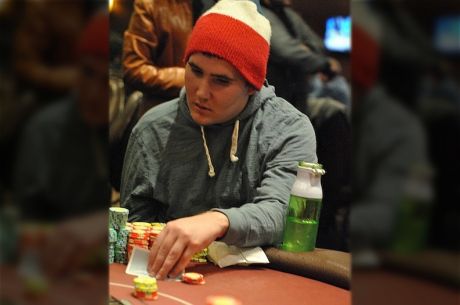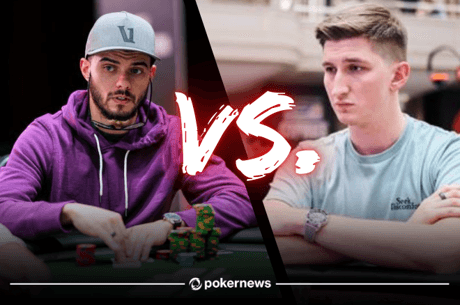Raise Big or Small? A Discussion of Open Bet Sizing from the 2015 WPT Borgata Main Event

Recently I was watching coverage of the 2015 World Poker Tour Borgata Main Event final table on Twitch, eventually won by David Paredes who topped a 1,027-entry field to earn the trophy and a $723,227 first prize.
Tony Dunst called the action and was joined in the booth by Allen Bari and Jamie Kerstetter who provided commentary and analysis. One of the first topics of discussion on the stream among the group was opening bet sizing.
Blinds began at at 40,000/80,000 with a 10,000 ante, and a player chose to open his first couple of hands to around 250,000. The three hosts all agreed that the sizing was big, but Bari seemed to see the merit in it while Kerstetter seemed to advocate a smaller opening size. Both gave compelling arguments.
Bari’s take on opening to 3x or more
Bari’s argument was that he understood why the player would want to raise bigger considering that nowadays players understand that they have to defend wide in the big blind due to the amazing price that they are getting versus smaller opens.

If you min-raise, the player in the big blind will be getting offered a price of 3.5-to-1 to make the call. With antes in play, the pot will be padded with nearly another big blind’s worth of dead money, which makes the big blind’s price even better.
If instead you open to 3x, the big blind would only be getting 2.25-to-1 (again, a bit better with antes). This means that you should win the pot immediately more often than you would with a min-raise. This is primarily the reason why pretty much everyone advocates raising bigger in blind-vs.-blind situations. In that scenario, most players would agree that a min-raise would not get a fold as often as you need it to with your wide range.
Another argument Bari made is if you min-raise and the big blind defends with an appropriately wide range, you will have a much tougher time putting the player on a hand postflop.
For example, when the flop comes 2♠3♦7♣, you can usually expect it to not have connected with the hand of someone who has called a substantial opening raise. This may not be the correct assumption, however, when you are facing a good player in the big blind who called a small raise getting nearly 4.5-to-1. In fact, the tables are turned here because he knows that he has more small card combos in his range than you do as the preflop raiser.
To illustrate his point, Bari recalled a time when he raised under the gun and a guy defended the big blind with 7x2x-offsuit. He seemed to be saying that he would rather make it bigger preflop and play against a narrower, more easily read range postflop.
Kerstetter’s take on opening to less than 3x
Kerstetter tended to disagree, stating that she would prefer a min-raise or just slightly more to the larger 3x raise.

Her argument was that she doesn’t mind when people defend with wide ranges, because she expects them to fold most of those hands by the river, allowing her to win an even larger pot than had they just folded preflop. A good example of the situation she was describing soon came up during the stream.
With the blinds still 40,000/80,000, a player in middle position made an opening raise to 175,000 with 7♦5♦ and the player in the big blind defended with 9♣8♥. The flop came A♠9♦4♠. After being checked to, the original raiser made a continuation bet which was quickly called by the big blind. The turn then brought the 6♦ which gave the raiser a huge combo draw and allowed him to barrel the turn after being checked to once more.
The pot was starting to get too big for the big blind who only had second pair with a bad kicker, so he decided to fold and the pot was awarded to the original raiser with his 7-high.
My take
I completely understand the arguments of both commentators, but like most questions in poker, I think this one boils down to “it depends.” I think your bet sizing when opening depends on the tendencies of the players behind you and on your primary reason for raising at all.
Kerstetter’s approach makes sense if you expect it to fold around to the player in the big blind who will then call with a wide range and fold by the river more often than not. My question is what if the big blind doesn’t fold by the river as much as we expect him to? Also, what if the players between you and the big blind rarely fold the action around, instead choosing to flat or three-bet a lot of their marginal hands?
If either is the case, a min-raise will often put you out of position in a multi-way pot with a much lower expectation of getting everyone to fold by the river. That said, this is not a bad thing if you actually want a call on the river, which leads me to my second point.
What is your primary reason for raising in the first place? If you are looking to steal pots with a wide range, then being out of position in a multi-way pot is a disaster. On the other hand, if you have a strong robust starting hand like KxQx-suited (for example), then this outcome is not so bad for you. I can imagine a scenario where the big blind defends with 7♠2♠ because he was getting a great price and you hold K♠Q♠. If the flop brings two spades, you are likely to win a nice pot whether the flush gets there or not. Chances are, this great scenario doesn’t happen if you make a large raise preflop.
To me it seems that if you are playing a strong range of hands and want action after the flop, then a smaller opening size makes sense if it is necessary to get the action you seek. If instead your primary objective is to steal pots with a wide range, then a bigger opening size makes sense if it is necessary to discourage the action you’d like to avoid. Balancing two separate ranges like this can be a difficult task, so maybe finding a middling sizing that accomplishes what you want from most of the hands in your range and using it with all the hands in your range is the best approach.
Conclusion
There was a time years ago in tournament poker when a raise to three or even four times the big blind was considered standard. Today this seems outrageously large as the new standard has come down to a min-raise or just slightly more.
Maybe the problem is the idea of a “standard” size at all. Maybe we should first think about what we want to accomplish with our bet, decide how to keep the players behind from interfering with our goal, and then size our raise accordingly. Doing this requires an on going reassessment of table conditions and an occasional willingness to go against poker’s cultural norms. I imagine that the constant focus and courage this would take has something to do with why so few players choose this approach.
Want to stay atop all the latest in the poker world? If so, make sure to get PokerNews updates on your social media outlets. Follow us on Twitter and find us on both Facebook and Google+!









